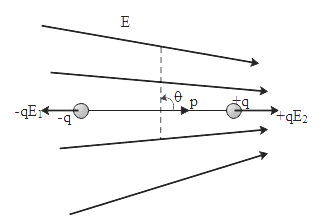
An electric dipole is placed in a non-uniform electric field, then
A. The resultant force acting on the dipole is always zero.
B. Torque acting on it may be zero.
C. The resultant force acting on the dipole may be zero.
D. Torque acting on it is always zero.
Answer
488.1k+ views
Hint: We can first draw a diagram to understand the direction of the electric field with respect to the dipole and from the diagram itself we can find the resultant force. The force acting on a charge is given as the product of charge and the field. Here we will also use the electric dipole moment to find torque acting on the dipole.
Formula used: \[\begin{align}
& p=qd \\
& \tau =p\times E \\
\end{align}\]
Complete step by step answer:
An electric dipole is an arrangement in which two equal and opposite charges are placed at a distance d cm. Its dipole moment is given as a product of charge and the separation between the charges. The direction of electric dipole moment is from negative to positive charge.

In the above diagram an electric dipole is placed in a non-uniform magnetic field. Then the forces experienced by the charges are in opposite directions and given as
\[\begin{align}
& F=(q{{E}_{2}})+(-q{{E}_{1}}) \\
& F=q({{E}_{2}}-{{E}_{1}}) \\
\end{align}\]
And \[{{E}_{1}}\ne {{E}_{2}}\]
Hence the resultant force will always be non-zero. Therefore option A and C are incorrect.
Now considering the torque, torque is the tendency of a force to rotate an object on its axis and it is given as a cross product of electric dipole moment and the electric field. Here torque which will be given as
\[\tau =p\times ({{E}_{1}}+{{E}_{2}})\]
In case the electric dipole gets parallel or antiparallel to the electric field then the torque will be zero.
So, the correct answer is “Option B”.
Note: Here the option is also given which says that torque is always zero which can’t be possible in both the case either its uniform electric field or non-uniform. It will be zero only if the electric field is parallel or antiparallel. It can be understood by formula, as it is a cross product it will have sine angle which will give zero in case of parallel or antiparallel.
Formula used: \[\begin{align}
& p=qd \\
& \tau =p\times E \\
\end{align}\]
Complete step by step answer:
An electric dipole is an arrangement in which two equal and opposite charges are placed at a distance d cm. Its dipole moment is given as a product of charge and the separation between the charges. The direction of electric dipole moment is from negative to positive charge.

In the above diagram an electric dipole is placed in a non-uniform magnetic field. Then the forces experienced by the charges are in opposite directions and given as
\[\begin{align}
& F=(q{{E}_{2}})+(-q{{E}_{1}}) \\
& F=q({{E}_{2}}-{{E}_{1}}) \\
\end{align}\]
And \[{{E}_{1}}\ne {{E}_{2}}\]
Hence the resultant force will always be non-zero. Therefore option A and C are incorrect.
Now considering the torque, torque is the tendency of a force to rotate an object on its axis and it is given as a cross product of electric dipole moment and the electric field. Here torque which will be given as
\[\tau =p\times ({{E}_{1}}+{{E}_{2}})\]
In case the electric dipole gets parallel or antiparallel to the electric field then the torque will be zero.
So, the correct answer is “Option B”.
Note: Here the option is also given which says that torque is always zero which can’t be possible in both the case either its uniform electric field or non-uniform. It will be zero only if the electric field is parallel or antiparallel. It can be understood by formula, as it is a cross product it will have sine angle which will give zero in case of parallel or antiparallel.
Recently Updated Pages
Master Class 12 Economics: Engaging Questions & Answers for Success

Master Class 12 Maths: Engaging Questions & Answers for Success

Master Class 12 Biology: Engaging Questions & Answers for Success

Master Class 12 Physics: Engaging Questions & Answers for Success

Master Class 12 Business Studies: Engaging Questions & Answers for Success

Master Class 12 English: Engaging Questions & Answers for Success

Trending doubts
Give simple chemical tests to distinguish between the class 12 chemistry CBSE

How was the Civil Disobedience Movement different from class 12 social science CBSE

India is the secondlargest producer of AJute Bcotton class 12 biology CBSE

Define peptide linkage class 12 chemistry CBSE

How is democracy better than other forms of government class 12 social science CBSE

Differentiate between lanthanoids and actinoids class 12 chemistry CBSE




